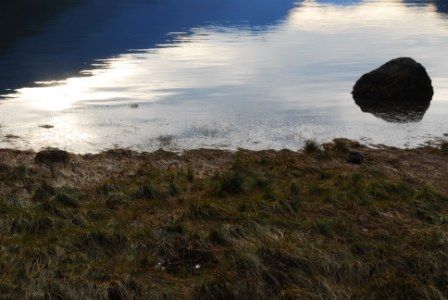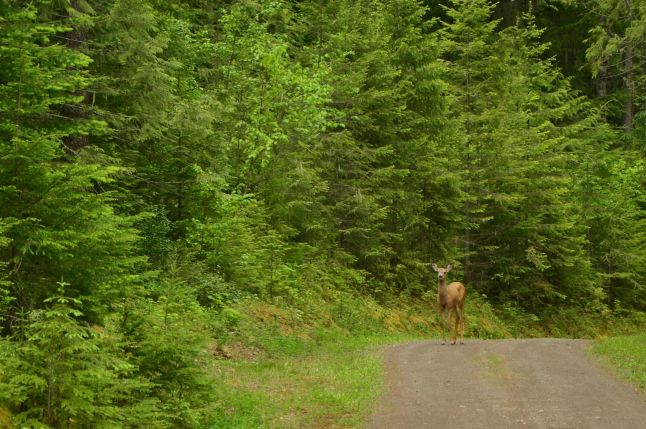The Landscape Ecology Research Group is closely affiliated with the Quesnel River Research Centre. There is considerable overlap between each groups respective focus. This page is dedicated to present members of the research group with an emphasis on those that have worked in the Quesnel River watershed. For information on previous members of the Landscape Ecology Research team please visit the Past Research section.
What is Landscape Ecology?
Landscapes are spatially diverse geographic areas made up of various ecosystems such as forests, grasslands, and lakes to human-dominated environments including agricultural and urban settings.According to the International Association of Landscape Ecology, landscape ecology is the study of spatial variation in landscapes at a variety of scales. It includes the biophysical and societal causes and consequences of landscape variation. Landscape ecology links natural science with related human disciplines and includes the following themes:
- The spatial pattern or structure of landscapes, ranging from wilderness to cities.
- The relationship between pattern and process in landscapes.
- The relationship of human activity to landscape pattern, process, and change.
- The effect of scale and disturbance on the landscape.
Landscape ecology in the context of Quesnel River watershed includes research issues such as:
- Modeling flows of energy, water, sediment, and chemicals through air, land, and water systems.
- Impacts of land use, change, and disturbance.
- Landscape conservation and sustainability.

FRBC Endowed Research Co-Chairs in Landscape Ecology
Dr. Phil Owens
FRBC Endowed Research Chair in Landscape Ecology
Phone: 250-960-6177
Email: Philip.Owens@unbc.ca
Dr. Owens’ main research interest is the effect of landscape disturbance (e.g. forestry, agriculture, mining, urbanisation, wildfire, climate change) on the behaviour, fluxes and fate of water, sediment and chemicals in the environment at a range of time and space scales, and the development of appropriate information and advice for improved management of land and water resources. Specific interests include:
-
Sediment sources, transport, storage and budgets,
-
Sediment management in river basins,
-
Soil erosion,
-
Effects of wildfire and forest disturbance on soil erosion and sediment fluxes,
-
Mountain geomorphic processes,
-
Fallout environmental radionuclides and other environmental tracers,
-
Nutrients and contaminants in soils and waters,
-
Ecology-water-sediment interactions.
For more information visit unbc.ca/owens
Dr. Ellen Petticrew
FRBC Endowed Research Chair in Landscape Ecology
Phone: 250-960-6645
Contact: Ellen.Petticrew@unbc.ca
The underlying theme of Petticrew’s research is the fate and effect of sediment moving from terrestrial systems through the aquatic system. Her work addresses the role of inorganic and organic sediments on the biological (plants, fish), chemical (nutrients, contaminants) and physical (sediment erosion and transport) aspects of land-water systems. Specific focus areas include:
-
Landscape scale linkages between terrestrial and aquatic systems,
-
Landscape disturbances on sediment transfers (fire, forest harvesting, agriculture),
-
Biogeomorphology: influence of organisms on physical attributes of aquatic systems and vise versa,
-
Ecological implications of transfers and storage of fine sediment (both organic and inorganic) in rivers and lakes,
-
Fine sediment morphology and composition (flocculation processes),
-
Lake restoration and community stewardship.
For more information visit, unbc.ca/petticrew
The Landscape Ecology Research Group is closely affiliated with the Quesnel River Research Centre. There is considerable overlap between each groups respective focus. This page is dedicated to present members of the research group with an emphasis on those that have worked in the Quesnel River watershed. For information on previous members of the Landscape Ecology Research team please visit the Past Research section.
Adjunct faculty
Dr John Rex
Forest Hydrologist
Ministry of Forests, Lands & Natural Resource Operations
Adjunct professor, Geography Program, UNBC
Email: john.rex@gov.bc.ca
Anadromous fish such as Pacific salmon play an important role in global nutrient cycling because they return substantial quantities of marine derived nutrients (MDN) to terrestrial and freshwater environments during spawning events. These MDN are known to support riparian zone vegetation and terrestrial organisms, benthic macroinvertebrates, algae, and other fisheries populations within natal watersheds. Despite the recognized importance of MDN to stream ecology, little is known about the underlying mechanisms for their delivery and retention in streams. The research I am completing at the QRRC under the supervision of Dr. Ellen Petticrew addresses that gap by investigating the role of flocculation in nutrient delivery to the streambed. Flocculation refers to the aggregation of inorganic and organic particles into 'flocs' by chemical, physical, or biological means. Using outdoor channels at QRRC that have been converted to both flow-through and re-circulating systems, we have been able to study floc formation, streambed delivery, and retention processes to determine the potential for salmon based flocs to play a role in nutrient delivery. To date our results suggest that flocs formed by the bacterial aggregation of salmon organic matter and clay delivers substantial amounts of nutrients to streambeds, enhancing their retention and biogeochemical cycling within Pacific salmon streams. These findings show that flocculation is integral to downstream nutrient cycling in Pacific salmon streams.

Adjunct faculty
Dr John Rex
Forest Hydrologist
Ministry of Forests, Lands & Natural Resource Operations
Adjunct professor, Geography Program, UNBC
Email: john.rex@gov.bc.ca
Anadromous fish such as Pacific salmon play an important role in global nutrient cycling because they return substantial quantities of marine derived nutrients (MDN) to terrestrial and freshwater environments during spawning events. These MDN are known to support riparian zone vegetation and terrestrial organisms, benthic macroinvertebrates, algae, and other fisheries populations within natal watersheds. Despite the recognized importance of MDN to stream ecology, little is known about the underlying mechanisms for their delivery and retention in streams. The research I am completing at the QRRC under the supervision of Dr. Ellen Petticrew addresses that gap by investigating the role of flocculation in nutrient delivery to the streambed. Flocculation refers to the aggregation of inorganic and organic particles into 'flocs' by chemical, physical, or biological means. Using outdoor channels at QRRC that have been converted to both flow-through and re-circulating systems, we have been able to study floc formation, streambed delivery, and retention processes to determine the potential for salmon based flocs to play a role in nutrient delivery. To date our results suggest that flocs formed by the bacterial aggregation of salmon organic matter and clay delivers substantial amounts of nutrients to streambeds, enhancing their retention and biogeochemical cycling within Pacific salmon streams. These findings show that flocculation is integral to downstream nutrient cycling in Pacific salmon streams.
Full text of Dr. Rex's PhD thesis
PhD Students
Alex Koiter
Ph.D. Candidate
Supervisors: Phil Owens and Ellen Petticrew
Email: akoiter@gmail.com
Increases in erosion rates and sediment loads within watersheds can cause serious environmental problems. Currently, the goal of research is to understand the source, fate, and transport of sediment mobilized within a watershed. This information is critical to developing and targeting management strategies that will reduce erosion rates and sediment loads. Sediment tracing is an emerging technique being used to help address these issues. This technique is based on the assumption that one or more of the properties of the sediment will reflect the source form where it originated from and can be used as a tracer to trace the sediment back to its sources. However, the processes that link the sediment sources to the point of collection are not well understood or quantified and currently there is an underlying assumption of a direct link between hill slope and downstream sediment in terms of property conservativeness. The main objectives of this research are to test the assumptions of tracer conservativeness by investigating how the physical and geochemical properties of sediments change as it moves though each of the three key areas of the landscape; the hill slopes, riparian zones and river channels. These objectives will be addressed with both field and experimental studies using the facilities at UNBC's Quesnel River Research Centre and field sites within the Quesnel River watershed.
Titi Kunkel
Ph.D. Candidate
Supervisors: Ellen Petticrew
Email: kunkel@unbc.ca
Dominic Reiffarth
Ph.D. Candidate
Supervisors: Phil Owens and Ellen Petticrew
Email: Dominic.Reiffarth@unbc.ca
Master's Students
Leah Vanden Busch
MSc Candidate
Supervisors: Drs. Ellen Petticrew & John Rex
Email: vandenbl@unbc.ca
Every year, millions of sockeye salmon travel hundreds of kilometres from the Pacific Ocean to their natal spawning grounds in the Quesnel watershed. The nutrient-poor freshwater systems in which they spawn receive an influx of marine-derived nutrients (MDN) upon the arrival of the salmon. These additional nutrients provide an important source of energy to enhance fish and aquatic productivity, as well as riparian wildlife and plant species. My research will investigate the hyporheic zone as an effective location of nutrient exchange between the streambed and riparian vegetation. The objectives will be to quantify concentrations of MDN present in hyporheic water samples, subsurface macroinvertebrates, and riparian vegetation throughout the 2011 spawning season and succeeding winter. In light of this research, we can gain a more comprehensive understanding of hyporheic nutrient exchanges that will facilitate better restoration and stream management decisions for the health of the ecosystem for future salmon stocks.
Mike Leggat
MSc Candidate
Supervisor: Dr. Phil Owens
Email:leggatm@unbc.ca
Suspended sediment generation processes during the ablation season at Castle Creek Glacier - In British Columbia, 20 % of the watersheds have enough glacial coverage to influence the quantity, quality, and timing of water and sediment delivered to downstream ecosystems. Glaciers have been receding since Little Ice Age, and will continue to recede under current climate projections. The effect of deglaciation on water resources has received more attention than the effect on sediment flux. However, both water and sediment have important implications for downstream infrastructure and ecosystems. As glaciers recede, highly erodible unconsolidated sediment is exposed in the proglacial zone. During glacial recession, sediment flux is expected to increase. As watersheds become deglaciated, available sediment may become transport limited due to a decreased contribution of glacial meltwater to stream flow. Additionally, proglacial sediment generation processes change over time as result of winnowing of fines and surface stabilization. In order to project future sediment flux, my research aims to quantify current fine sediment generation processes, as well as the temporal effect on sediment availability in the proglacial zone of the Castle Creek Glacier; which is an upper tributary of the Fraser Basin in the Cariboo Mountains of British Columbia.
Kristina Anderson
MSc Candidate
Supervisor: Dr. Phil Owens
Email: kristina.anderson@gov.bc.ca
Role of riparian buffers in regulating water flows in agricultural landscapes.
Jocelyn Joe-Strack
MSc Candidate
Supervisor: Dr. Ellen Petticrew
Email: joestra@unbc.ca
New methods are continuously developed to effectively and efficiently trace sediment from its source along catchment pathways. A relatively recent approach marries genetic techniques to sediment analysis in order to characterize and differentiate the bacterial populations associated with soil and/or sediment originating from specific locations. Here we present the preliminary results of DNA fingerprint profiles of soil and sediment-associated bacterial communities in and around two different industrial land uses in the central interior of British Columbia, a feedlot and a copper/gold mine. Samples from these sites associated catchment pathways were assessed using amplicon length heterogeneity-polymerase chain reaction (LH-PCR) to differentiate the naturally varying 16S rDNA gene. Statistical differences between bacterial community profiles were investigated using a suite of methods of which non-metric multidimensional scaling (NMS) and indicator species analysis (ISA) were the most useful. Stronger statistical results were observed for the feedlot data set with spatial differences observed from the source location and within the adjacent creek. Results from the mine site were more difficult to assess although responses were detected in downstream waterways. While bacterial DNA fingerprinting of soil and sediment appears to be a promising tracing technique issues of scale and transferability may limit its use. Lessons learned from this preliminary study will be presented.